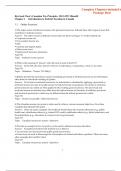Exam (elaborations)
Test Bank for Byrd & Chen's Canadian Tax Principles, 2024|2025 Edition Vol 1 by Gary Donell
Test Bank for Byrd & Chen's Canadian Tax Principles, 2024|2025 Edition Vol 1 by Gary Donell, Clarence Byrd, Ida Chen. Volume 1 (Chap 1 to 10) are included in this document however Complete chapters are included in Package deal of this document. 1 Introduction to Federal Taxation in Canada 2 Pro...
[Show more]



